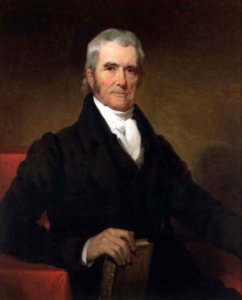There are some Supreme Court cases that you should just know because they are important; they have some impact on U.S. policy or they expand rights dramatically. In many ways, though, Marbury v. Madison tops those cases because, without this case, the Supreme Court would not be the Supreme Court we know (and love?) today. Before you start reading, though, full disclosure: I’m a pretty big Supreme Court dork. 🙂 Read on to learn about Marbury v. Madison APUSH topics.
What is Marbury v. Madison all about?
It’s an old tale of political rivalries and backstabbing (if you’ve seen or heard Hamilton – or even watched the news recently – you know what I’m talking about).
As you know as a student of U.S. history, John Adams was not a particularly popular President. He served one term and was pretty unaccomplished at that (with Alexander Hamilton as your rival, it’s no small surprise he wasn’t able to get much done!).
But as he left the Presidential office – an apocryphal story says that it was literally as he was leaving the office and Thomas Jefferson, the third President of the United States, was coming in – Adams made many political appointments, trying to secure his own party’s place in the bureaucratic offices. One of these appointments included William Marbury, who was supposed to serve as a justice of the peace for the District of Columbia.
Adams thought he had stuck it to Jefferson. “Sure, dude,” Adams probably thought to himself, “Go ahead and take my office. But I’m going to make your job so hard with all of my political appointees in important roles.” But Jefferson’s Secretary of State, James Madison, refused to deliver Marbury’s commission papers. (Remember, at that time, someone had to literally hand you your papers to give your claims to a government position any credibility.)
Jefferson’s administration just didn’t do this with Marbury’s commission papers; they were refusing to deliver commission papers all over the place. So, Marbury and three other scorned political appointees sued Madison for the commissions; this case would be known as Marbury v. Madison.
OK, so what happened in Marbury v. Madison?
Things get complicated here. I thoroughly recommend that you listen to the podcast episode called “Kittens Kick the Giggly Blue Robot All Summer” from RadioLab’s More Perfect podcast.

Public domain painting of John Marshall (Source)
The big idea here is that, in 1803, Chief Justice John Marshall refused to decide the issue. According to the Court’s reasoning (written in a majority opinion by Marshall), the Constitution did not give the Supreme Court authority to solve this issue.
It was really quite an elegant decision. In the short term, Marshall was saying that the Supreme Court was limited in its decision-making ability. (After all, their decision in this case was basically that they couldn’t make a decision in this case, because they didn’t have the authority.) But the long-term effects were that the Court had the authority to interpret whether or not something was Constitutional.

(Source)
Did your brain just explode?! Because that is incredible.
THE SUPREME COURT HAS THE ABILITY TO DETERMINE WHETHER OR NOT SOMETHING IS CONSTITUTIONAL.
Marshall, Supreme Court: 1
Adams, Marbury, & co: 0
OK, OK. Why does Marbury v. Madison matter so much?!
I thought you’d never ask. First check out this concept of Judicial Review, as explained by History Illustrated:
The concept that the Supreme Court can determine whether or not a law is constitutional is called Judicial Review, and it has huge implications for U.S. history. The Supreme Court is an ultimate check on power.
Furthermore, it is one of those sweet pieces of historical irony that brings judicial review into being. It’s only through a political move—Marshall, a Federalist, wanted Jefferson to know that his party did not have unfettered control to do as they wished—that the Supreme Court came to be seen as apolitical for most of its history.
Jefferson recognized the importance of Marshall’s move when he stated that the Court could make the Constitution “a mere thing of wax in the hands of the judiciary, which they may twist and shape into any form they please.”
What is an example Marbury v. Madison APUSH question?
The following Marbury v. Madison APUSH question comes from this quiz source.
“So if a law be in opposition to the constitution; if both the law and the constitution apply to a particular case, so that the court must either decide that case conformably to the law, disregarding the constitution; or conformably to the constitution, disregarding the law; the court must determine which of these conflicting rules governs the case. This is of the very essence of judicial duty.”
Which of the following statements accurately summarizes the concept of judicial review, as established by Marbury v. Madison?
A. The Supreme Court should review laws that conflict with the Constitution but cannot declare a law is unconstitutional.
B. When the law and Constitution conflict, it is impossible to know which takes precedent.
C. When the law and Constitution conflict, the Supreme Court will always rule in favor of the law.
D. The Supreme Court should review laws that conflict with the Constitution and can strike down a law as unconstitutional.
Answer:
The correct answer to this Marbury v Madison APUSH question is D. This is the process of judicial review.





